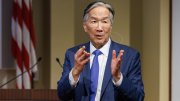Harvard College announced today that the 2012-2013 academic year term bill will be $54,496—an increase of 3.5 percent, or $1,844, from $52,652 in the current year. In percentage terms, this increase reflects a more moderate increase than that imposed during the recent past (a rise of $1,855, or 3.8 percent, from 2009-2010 to 2010-2011, and of $1,929, also 3.8 percent, in the subsequent year).
Higher tuition and fee revenues are, ironically, one of the principal ways the College can fund increases in financial aid (see discussion below). View a 20-year history of the Harvard College term bill, from the Harvard University Fact Book, published by the provost's office.

In recent years, the Faculty of Arts and Sciences (FAS) has increased spending on financial aid at a higher rate than tuition and fees, reducing its net revenues from these sources—the largest stream of unrestricted funds. Because such unrestricted funds are the principal short-term source of revenue to augment financial aid, the faculty will likely make endowed support for financial aid a major capital-campaign objective (see discussion below). Source for data: Managerial Financial Report appendix to FAS Dean's Annual Report
The sticker price of attending college has become a political issue: President Barack Obama and Secretary of Education Arne Duncan have proposed incentives for institutions to restrain the growth in tuition and term bills. And public colleges have been hard-pressed by sharp reductions in state appropriations during the recession; the "State Higher Education Finance FY 2011" report, just published, observes, "State and local support…per full-time-equivalent student was $6,532 in 2010, a $500 constant [inflation-adjusted] dollar (or 7 percent) decrease from 2009, and the lowest in the last 25 years. The trend continued in 2011 with state and local support per FTE at $6,290, an additional 3.7 percent decrease," driven largely by increasing enrollments. These institutions have increasingly raised their student charges by large percentages; given that they often lack endowment support for generous financial aid, the cost of attending them has effectively become higher, in some instances, than that for some of the elite private universities and liberal-arts colleges—despite the latter institutions’ much higher nominal charges.
Inside Higher Ed addressed many of these issues in “What, Isn’t This the Old Normal?” in its daily report of March 21. Among the observations reported there:
- “The tuition announcements by Princeton… and others came as somewhat of a surprise to many in the field, who believed the market for higher education changed in 2008 when many families’ savings took a significant hit.”
- “Public four-year universities raised tuition an average of 8.3 percent last year, compared to an average 4.5 percent increase in privates. Increases in the University of North Carolina system for next year will average close to 9 percent. Price hikes will be similarly large for the California State University System…. [B]ecause they are starting from a lower baseline, the total dollar increase for these institutions is still less than the smaller percentage increases at privates."
But because of differing revenues, “Despite a sticker price that was several times greater, Princeton actually took in less money in net tuition revenue per student in 2009 than did several prominent public institutions, including the University of Virginia and the University of Michigan. It took in only about $500 more per student than did the University of California at Berkeley and the University of North Carolina at Chapel Hill, two public institutions notable for low tuition prices.”
That report also highlighted private institutions’ slightly different pricing strategies, driven by their financial circumstances. Princeton, for instance, raised its bill 4.5 percent this year—apparently its largest boost in six years—to a total of $53,130; it noted that it is still drawing on reserves to balance its budget. Yale’s term bill will increase 4.9 percent, to $55,300; Yale is still making cuts in an effort to reach budgetary balance this year. Stanford, which cut more heavily at the outset of the financial crisis, according to the Inside Higher Ed report, is imposing lesser price increases in its term bill for next year.
Augmenting Undergraduate Aid
Like these peer institutions, Harvard is increasing financial aid—for students in the College, to $172 million next year from an announced $166 million in the current year (a 3.6 percent rise). Financial-aid spending is consequential for the Faculty of Arts and Sciences’ fiscal health overall; as previously reported, the consolidated cost of financial aid from all sources outstripped the growth in tuition and fees collected during fiscal year 2011 (ended last June 30), for the faculty as a whole (the College and Graduate School of Arts and Sciences), so that despite announced increases in the sticker price, the net tuition and fee revenue retained actually declined (see the table above).
Tuition and related fees account for about two-thirds of the faculty’s unrestricted revenue—so increases in the term bill are a very important means of paying for increases in financial aid. The projected net tuition and fees (after financial-aid disbursements) for the current fiscal year, and the budgeted targets for next year, are not yet known. As reported, from fiscal 2009 through 2011, spending for financial aid within the faculty’s core operations from unrestricted funds more than doubled, to $89 million, limiting its financial flexibility severely—and making more urgent the anticipated fundraising efforts in the forthcoming University capital campaign that will be aimed at securing endowment support for financial aid.








